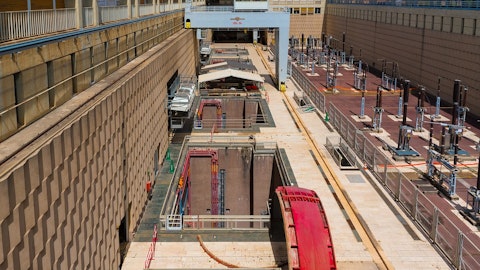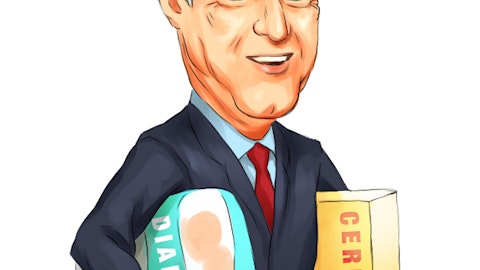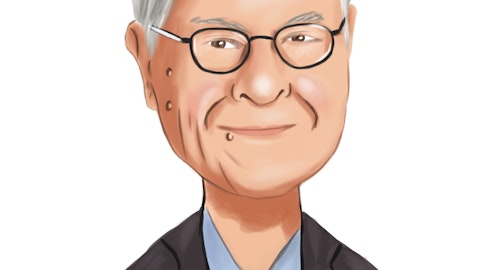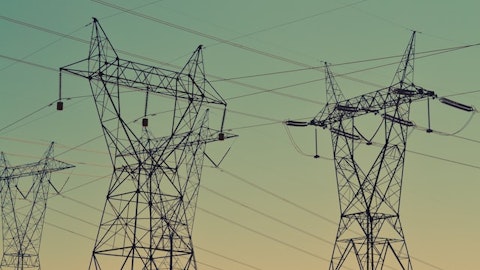Otter Tail Corporation (NASDAQ:OTTR) Q3 2023 Earnings Call Transcript October 31, 2023
Operator: Good morning, and welcome to Otter Tail Corporation’s Third Quarter 2023 Earnings Conference Call. Today’s call is being recorded. We will hold a question-and-answer session after the prepared remarks. I will now turn the call over to the company for their opening comments.
Beth Osman: Good morning, everyone, and welcome to our third quarter 2023 earnings conference call. My name is Beth Osman, and I’m Otter Tail Corporation’s Manager of Investor Relations. Last night, we announced our third quarter financial results. Our complete earnings release and slides accompanying this call are available on our website at ottertail.com. A recording of this call will be available on our website later today. With me on the call today are Chuck MacFarlane, Otter Tail Corporation’s President and CEO; Kevin Moug, Otter Tail Corporation’s Senior Vice President and CFO, and Todd Wahlund, Otter Tail Power Company’s Vice President of Finance and CFO. Before we begin, I want to remind you that we will be making forward-looking statements during the course of this call.
As noted on Slide 2, these statements represent our current views and expectations of future events. They are subject to risks and uncertainties, which may cause actual results to differ from those presented here. So please be advised about placing undue reliance on any of these statements. Our forward-looking statements are described in more detail in our filings with the Securities and Exchange Commission, which we encourage you to review. Otter Tail Corporation disclaims any duty to update or revise our forward-looking statements due to new information, future events, developments, or otherwise. I will now turn the call over to Otter Tail Corporation’s President and CEO, Mr. Chuck MacFarlane.
Charles MacFarlane: Thank you, Beth. Good morning and welcome to our third quarter 2023 earnings call. Please refer to Slide 4, as I begin my comments on our third quarter results. Through the combined efforts of our employees and diversified business model, we delivered record-setting quarterly earnings. We generated earnings per share of $2.19, driven by increased earnings from our Manufacturing and Plastics segments, along with a reduction in corporate costs. Our Electric segment earnings in the quarter were largely flat to last year, but are up 7% on a year-to-date basis. Based on our strong quarterly and year-to-date results and revised expectations for the remainder of the year, we are increasing our 2023 diluted earnings per share guidance to a range of $6.76 to $6.96 from our previous range of $5.70 to $6.
This increase was primarily driven by Plastics segment performance continuing to remain stronger than previously expected. In a moment, Kevin will provide a more detailed discussion of our third quarter financial results and our expectations for the remainder of the year. Slide 5 shows our expected five-year compounded annual growth rate in earnings per share with and without the impact of our Plastics segment through the end of 2023 based on the midpoint of our updated earnings guidance. We expect to produce a compounded annual growth rate in earnings per share from 2018 through 2023 of 11% exclusive of our Plastics segment. The additional earnings and cash flows generated by our Plastics segment over this time period provides additional strength to our already strong credit metrics, liquidity, and capital structure, and allows for capital investment in our operating companies.
Turning to Slide 7, we illustrate Otter Tail Power’s efforts in working toward a cleaner energy future. Hoot Lake Solar becoming operational in August of this year, we expect nearly 40% of Otter Tail Power’s owned and contracted energy sources will come from renewable resources. This represents an exciting milestone as we continue to transition to a cleaner energy future while still maintaining reliability and affordability for the communities we serve. Turning to Slide 11, in March, Otter Tail Power filed a supplemental Integrated Resource Plan with each of our three state utility commissions. In Minnesota, we received initial comments from intervenors in September and filed reply comments yesterday. We anticipate a hearing with the Minnesota Public Utilities Commission in early 2024, and we expect to receive initial comments from the North Dakota Public Service Commission sometime next week and anticipate an informal hearing later this year.
Slide 12 provides an overview and status update on our significant capital investment projects. Our team continues to effectively execute our project plans, working to secure projects that are completed on time and on budget. I will now provide a few details on several projects. On Slide 13, an overview of Otter Tail Power’s 49-megawatt Hoot Lake Solar project is provided. The construction of the facility was completed on time and on budget, and became fully operational in August. The facility was constructed on and near the retired Hoot Lake coal plant property in Fergus Falls, allowing us the unique opportunity to utilize existing transmission rights, land, and substation assets. Hoot Lake Solar is the least cost and third largest operating solar site in the State of Minnesota, and its completion marks another step towards a cleaner energy future.
Slide 14 summarizes Otter Tail Power’s investments under Tranche 1 of MISO’s Long Range Transmission Plan. Otter Tail Power co-own two Tranche 1 projects, the Jamestown-Ellendale and the Big Stone South-Alexandria to Big Oaks, 345 kV transmission projects. Our team is focused on project development and coordinating these complex projects with our co-owners. Both projects have FERC approval for construction work in progress recovery, ensuring the timely recovery of our capital investment. In total, we estimate Otter Tail’s capital investment in these projects will be approximately $420 million with 30% of the capital investment to occur before 2028. These investments have very limited impact on our retail customer rates, as they are allocated across the MISO Midwest footprint.
Our team continues to monitor developments at MISO regarding potential Tranche 2 transmission projects. MISO is currently indicating Tranche 2 projects will be approved in 2024. While we expect some investment opportunity for Otter Tail Power arising from Tranche 2 projects, our five-year capital plan does not include any estimates of future investments for these projects. In addition to the transmission investment opportunities available through MISO’s Long Range Transmission Planning, MISO and the Southwest Power Pool or SPP recently partnered to develop the Joint Targeted Interconnection Queue or JTIQ portfolio projects, focused on improving the reliability of the grid, where the two regional transmission organizations connect. The Minnesota Department of Commerce, on behalf of MISO and SPP, applied to the U.S. Department of Energy for funding to support the JTIQ projects.
The DoE awarded $464 million to five of these projects, one of which, we are expecting to co-develop with Xcel Energy. While these projects still need to go through the approval process with FERC, we are optimistic about the eventual outcome and the potential investment opportunity. Similar to the MISO Tranche 2 projects, we have not yet included this project in our five-year capital forecast. Turning to Slide 15, we intend to repower four of our legacy wind farms in 2024 and 2025 with an investment of approximately $230 million. Each project qualifies for renewed production tax credits with the passage of the Inflation Reduction Act, and is anticipated to lower customer bills, demonstrating Otter Tail Power’s continued focus and commitment to customer affordability.
Slide 16 provides an overview of Otter Tail Power’s capital spending plan. The plan includes $1.1 billion of capital investment over the next five-year period and produces a 6.5% annual compound growth rate in rate base over this timeframe. It is important to highlight that we have potential additional renewable investment opportunities after 2027, as outlined in our IRP, as well as incremental transmission investment opportunities relating to MISO Tranche 2 and JTIQ projects. We anticipate approximately 80% of our capital investments will be recovered through existing rates or riders. Slide 17 provides an overview of key regulatory matters for 2023. Based on the results of our cost-of-service studies, we determined it prudent to file a general rate case in North Dakota.
We will be filing our case on November 2nd, 2023. Slide 18 provides a summary of our planned rate case filing with the North Dakota Public Service Commission, in which we will be proposing a rate net increase in revenues of approximately $17 million, or 8.4%, based on a requested ROE of 10.6% on an equity layer of 53.5%. The rate case is driven by increases in our operating costs since our last case filing in the state of North Dakota, which was over six years ago. Even with this increase, Otter Tail Power will continue to have some of the lowest rates in the country. Turning to our Manufacturing segment on Slide 22, end–market demand is mixed, but our existing customers continue to look to us to add value, resulting in incremental volumes from winning additional work with existing customers.
Within the recreational vehicle and lawn and garden end markets, discretionary spending is being impacted by inflation and rising interest rates. However, within the recreational vehicle end market specifically, we have seen a shift to higher-end models as buyers of these models seem to be better insulated from economic pressures. Construction remains a strong end market for us, as distributors are still experiencing low levels of inventory with a buildup of fleet replacement needs over the last few years. The agriculture end market is stabilizing as inventory has started to build. And the power generation end market continues to be healthy for us as demand remains high and inventory levels low. Our BTD Georgia expansion, expected to cost approximately $20 million, is currently underway.
We expect to bring the additional capacity online in early 2025. At T.O. Plastics, sales volumes in the horticulture end market decreased in Q3, as lead times have normalized and customers continue to work through inventory purchased early due to scarcity concerns, resulting in lower operating revenues this quarter as compared to the same time last year. Slide 25 provides an overview of our Plastics segment. Sales volumes were relatively flat in Q3 compared to the same time last year, and we believe distributor inventory destocking is generally complete. Slide 26 highlights historic resin costs and PVC pipe pricing. The Plastics segment produced stronger operating margins as our sales price to resin spreads have improved compared to the third quarter of 2022.

The sales price of PVC pipe has receded from historic highs and continues to do so. This decline is at a pace slower than the reduction in cost of resin and other materials over the same timeframe. Our updated PVC pipe pricing expectations as well as related margins for the remainder of the year are the primary drivers for our increased 2023 earnings guidance that Kevin will expand on. The Vinyltech expansion and plant upgrade is underway, and we anticipate the expansion will increase capacity by approximately 8% or 26 million pounds for the segment. We currently expect to bring this new capacity online in the second half of 2024 at a cost of $50 million. I’ll now turn it over to Kevin to provide additional commentary on our third quarter results and our updated outlook for 2023.
Kevin Moug: Well, thank you, Chuck. Good morning, everyone. We delivered record-setting quarterly financial results with diluted earnings per share of $2.19. Our financial results for the trailing 12 months ended September 30, 2023 resulted in a 21.8% return on equity on an equity layer of approximately 62%. Please follow on Slide 30 as I provide an overview of our third quarter segment earnings. Electric segment earnings decreased approximately $300,000 or 1% as compared to the third quarter of 2022. This was driven by increased operating and maintenance expenses, primarily due to higher labor costs and strategic spending initiatives, higher depreciation expense, and the impact of unfavorable weather. These items were partially offset by increased rider recovery revenues from our Hoot Lake Solar and Ashtabula III investments, increased commercial and industrial sales volumes, and lower pension plan costs.
Manufacturing segment earnings increased $1.2 million or nearly 20% compared to the same time last year. Key elements driving this increase include the following. BTD Manufacturing has been successful in adjusting sales prices in response to the labor and non-steel material cost inflation, resulting in higher profit margins in the third quarter of 2023 as compared to the same time last year. Also, sales volumes for BTD Manufacturing increased in the third quarter, driven by end-market demand in the construction, recreational vehicle, and power generation end markets as well as incremental volumes from winning additional work with existing customers, as they continue to look to us to add value. Partially offsetting this increase, T.O. Plastics sales volumes within the horticulture end market declined in the third quarter of 2023 compared to the same time last year, as customers continue their destocking efforts and return to more normal buying patterns.
Plastics segment earnings increased $3.2 million or approximately 6% compared to the third quarter of 2022. The increase in earnings is primarily due to increased profit margins for the segment, as our sales price to resin spreads improved in the third quarter of this year as compared to the same time a year ago. Both the sales price of PVC pipe and the cost of resin continued to decline, but the sales price has declined at a rate slower than resin costs. Sales volumes were largely flat as compared to the same time last year, and we believe customers are generally through their destocking efforts. Corporate costs declined $3.6 million in this quarter compared to the same time last year. This improvement resulted from lower employee health insurance claim costs and the investment income earned on our short-term cash equivalents in the third quarter of 2023 was higher due to improved yields and higher invested funds.
Moving on to our updated earnings guidance, Slide 33 provides that updated outlook. We are increasing our earnings per share guidance to a range of $6.76 to $6.96, a 17% increase from the midpoint of our previous guidance range of $5.70 to $6. We are tightening the range of expected earnings for our Electric segment and expect our utility to produce earnings growth of 6% over 2022. We are increasing the Manufacturing segment earnings guidance due to the strength of third quarter earnings as higher sales volumes, margin improvement, and higher research and development credits drove earnings growth at BTD. We are increasing the earnings guidance for our Plastics segment due to continued strength in sales prices and related operating margins of PVC pipe.
While sales prices and margins have begun to recede from historic highs, the rate of decline continues to be slower than we anticipated. We expect sales prices to decline modestly over the fourth quarter, resulting in a decline in operating margins. Additionally, we now expect stronger sales volumes in the fourth quarter as distributors are generally through their destocking efforts with demand rebounding in advance of a seasonal decline anticipated in the latter part of the fourth quarter. And finally, we are improving our guidance for corporate costs. This relates to our third quarter results, and an increase in expected earnings and our short-term cash equivalents due to higher level of invested funds and increased yields on those investments.
Additionally, we expect lower employee healthcare costs through the remainder of the year. We now expect our earnings mix for 2023 to be approximately 30% from our Electric segment and 70% from our Manufacturing and Plastics segments, net of corporate costs. This anticipated mix deviates from our long-term expected earnings mix of approximately 65% Electric and 35% non-Electric, as our Plastics segment continues to produce elevated earnings. We continue to monitor various economic indicators such as single and multi-family housing starts, interest rates, and consumer confidence levels to ensure we are well positioned across our portfolio when change occurs. Our diversified business model continues to generate strong financial results for our stakeholders and has put us in an enviable position.
The higher level of earnings and cash flows generated over the last two years continues to strengthen our balance sheet. Looking to Slide 32, our consolidated equity layer as of September 30, 2023 was nearly 62% as compared to 59.4% as of December 31, 2022 and 53.7% as of December 31, 2021. In September, Fitch upgraded the credit rating of both Otter Tail Corporation and Otter Tail Power Company in response to our strengthened financial position and credit metrics. S&P maintained its credit rating for Otter Tail Power Company. We believe it is prudent to retain our excess cash given all the regulated investment opportunities existing at Otter Tail Power Company, not only in the current five-year period, but beyond. Additionally, our current cash position and balance sheet differentiates us from others in the utility sector, as we have no equity needs over the next five years despite our sizable CapEx plans.
With our strong financial position and track record of being able to deliver our capital investments on time and on budget, we feel confident in our ability to continue to execute on our rate base growth plans. Our exposure to rising borrowing costs continues to be low-risk. We don’t have any outstanding borrowings on our parent company facility and the amounts drawn on the utility facility primarily relate to capital projects. The increased cost of these borrowings is fully considered in our updated 2023 guidance. As of September 30, 2023, our parent debt to total company debt is 9%. The $80 million, 3.55% parent company note matures in December of 2026, and this is our only outstanding debt at the parent level. Slide 39 reflects the collective strategies of our platforms and financial performance targets.
This business model continues to serve us well, and we remain in the enviable position to fund our rate base growth opportunities at the utility with a strong balance sheet, ample liquidity to support our businesses, and strong investment-grade corporate credit ratings.
Charles MacFarlane: Before we open the call for questions, I want to take a moment to recognize Kevin who recently announced his retirement effective at the end of the year. I’d like to thank Kevin for his years of service and contributions to Otter Tail Corporation, its employees, and customers. Kevin has been a pillar of integrity for our company and has helped us shepherd through challenging times and enviable financial success. With the deepest gratitude, we congratulate Kevin and wish him all the best in his retirement.
Kevin Moug: Well, thanks for the kind words, Chuck. My 27 years of working for Otter Tail is filled with wonderful memories, challenges, and accomplishments. It has been an honor to work for the company, alongside the employees across our Electric and Manufacturing platforms. It has also been a privilege to have worked with all of you and I value the relationships we have developed. The support and confidence you have provided me during my tenure is most appreciated. The company is in wonderful hands. And so on January 1, I will hand the football to Todd Wahlund as my successor. He is well prepared to move into the role as he has served as VP of Financial Planning and Treasury at the corporate level, VP of Finance and Planning for our Manufacturing platform, and most recently as Chief Financial Officer and VP of Finance for Otter Tail Power Company.
A – Todd Wahlund: Thank you, Kevin. I too extend my congratulations and best wishes to you in your retirement. Your leadership has been an outstanding model to follow, and I appreciate all your guidance and coaching over the years. I am grateful for the opportunity to continue your legacy of excellence and execution on a solid growth strategy. We are now ready to take your questions.
Operator: Thank you. [Operator Instructions] After the Q&A, Chuck will return with a few closing remarks. One moment, please. And our first question comes from the line of Chris Ellinghaus with Siebert Williams Shank & Company.
See also 12 Most Important Holidays in the US and 11 Best Long-term Stocks To Buy For High Returns.
Q&A Session
Follow Otter Tail Corp (NASDAQ:OTTR)
Follow Otter Tail Corp (NASDAQ:OTTR)
Chris Ellinghaus: Hi, everybody. How are you?
Kevin Moug: Good morning, Chris.
Charles MacFarlane: Good morning.
Chris Ellinghaus: Chuck, could you talk about the IRP process? What are you hearing from intervenors so far?
Charles MacFarlane: Well, in the Minnesota filing, which we filed comments — reply comments yesterday, we have comments from the Clean Energy Organization, Minnesota Office of Attorney General, and the Minnesota Department of Commerce. The environmental intervenors brought up issues on the retirement timing of Coyote and Big Stone as related to the proposed CO2 regulations in front of the EPA. We’ve replied to that. There is also some comments in there about Otter Tail’s use of renewable energy credits to meet the Minnesota clean energy standard in — by 2040, and then some comments by OAG, and very similar comments. The DoC reviewed our modeling and inputs and did not have substantial comments on their own modeling at that time.
Chris Ellinghaus: Okay. Great. Kevin, can you sort of talk about the Plastics business? And have you got any sort of update on your thoughts on the glide path to a more normal time?
Kevin Moug: Yeah, Chris. As we both said in our comments that this glide path down is just taking longer than we would have expected. We — as we — I think we mentioned on the second quarter call, we were starting to see downward pressure in our — residential commercial market, particularly in the Northern Pipe territory as some competitors dropped prices as they were looking to pick up some market share. The declines in the municipal water market, while they’re softening, they aren’t softening to the levels that we expected when we updated our guidance at the end of the second quarter. As we look today into, clearly conditions are stronger than we expected middle of the year, we — as evidenced by the strong third quarter and another uplift in the guidance for 2023.
We aren’t seeing anything today, any kind of catalyst that says there should be any precipitous drop in pricing as we head into 2024. And we continue to monitor those conditions. We’ll certainly provide an update on the — when we give 2024 guidance in February where those conditions are, but we think that the path to a more normal view of earnings is probably longer than what we had previously expected. We said in the second quarter call that we expect that we’ll see some type of normalization in the last half of 2024. I think that glide path is still there, Chris, but it could continue to be longer while it starts to come back in the last half of ’24 and into ’25. I still think there’s a — as we see it today, a longer glide to get back to normal.
Chris Ellinghaus: Okay. Great. And Chuck, can you just remind us of the procedural sort of schedule in North Dakota? Is it still a seven-month statutory review?
Charles MacFarlane: Yes, Chris, it is. And in many cases in North Dakota, there are settlements that occur before that seven months, but a fully litigated case has approximately a seven-month window.
Chris Ellinghaus: Okay. And in the rate case, can we presume the test year is something in 2024 and is the $17 million, is that the base revenue request?
Charles MacFarlane: The $17 million is the net new. We’re in the process. We have a number of riders that would roll into base rates, but the net new revenue request is the $17 million. And we do use 2024 North Dakota as forecast test year.
Chris Ellinghaus: Okay. Great. Kevin, good luck with the retirement. We’re going to miss you. Thanks for the details, everybody.
Kevin Moug: Yeah. Thanks, Chris. We’ll see you at EEI.
Operator: Thank you. [Operator Instructions] And our next question comes from the line of Sophie Karp with KeyBanc Capital Markets.
Unidentified Participant: Good morning. This is actually Michael stepping in for Sophie. Thanks for taking my question. I was just wondering, on the Manufacturing segment, if you could remind us how much capacity the Georgia expansion project will add.
Kevin Moug: In terms of dollar size, Mike?
Unidentified Participant: Just total capacity addition.
Kevin Moug: Yeah. I think it’s adding collectively around 40 million of capacity.
Unidentified Participant: Okay.



